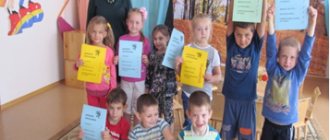From the author
The successful implementation of program objectives depends on a number of factors and, above all, on the way of life of a preschool institution, the atmosphere in which the child is raised, and on a specially designed, thoughtful developmental environment.
The effectiveness of education and training is achieved through the painstaking work of teachers who work directly with children and all preschool employees who communicate with preschoolers during the day.
The system of work on teaching children their native language, introducing them to fiction is presented in the works of V. V. Gerbova “Development of speech in kindergarten”, “Introducing children to fiction” (M.: Mozaika-Sintez, 2005).
The manual “Classes on speech development in the first junior group of kindergarten”, written within the framework of the “Program of education and training in kindergarten” edited by M. A. Vasilyeva, V. V. Gerbova, T. S. Komarova, supplements recommendations on the most important direction of pedagogical activity - purposeful and systematic training of preschoolers in the classroom. The practical purpose of the book is to provide educators with approximate guidelines for planning lessons (defining topics and learning goals, ways to implement them).
Article “Organization of speech development classes in a nursery group”
Organization of speech development classes
with children from the nursery group of the kindergarten.
F. M. Mugotleva, teacher
MBDOU "Kindergarten No. 23" Berezka ", Maykop
Activities with children in the nursery group are playful in nature. However, they have certain goals, objectives, and means for their implementation and thus differ from games. From the very beginning of classes, the teacher sets a goal - to instill in children certain rules of behavior: not to disturb others, maintain the correct posture, listen carefully and perceive what is being shown. Children's observance of rules of behavior soon becomes a habit, and the result of an action, movement, or word performed serves as a source of joy.
The education of young children is unique. Firstly, they not only have no motives for learning activities, but also lack conscious, voluntary actions necessary for learning, and the acquisition of first knowledge and skills occurs on the basis of involuntary memorization. Secondly, in spite of everything, young children have a high level of learning ability, that is, the learning process begins long before this type of activity becomes the main one in the child’s mental development.
Speech classes are the most difficult for children, require tension and therefore should be short. When fatigue appears, children are either involved in the activity or finished early. It is important that the kids get complete satisfaction from the lesson.
In order for children to be less distracted during the lesson and it to be more effective, it is advisable to organize it in a different room, not where those who are not engaged are playing. This could be a reception room, a well-lit bedroom.
It is important to provide the most comfortable position for the child during classes, which will help him maintain attention for a long time. Children often play while sitting on the floor, so they do not develop differentiation well, so that during classes they need to behave differently than during play. They jump up, crawl around, grab toys, get distracted. Sitting on the carpet with your legs outstretched is not a comfortable position; children get tired quickly. They are trying to change it. And at this moment he interferes with another child.
If children at the beginning of the 2nd year are seated during class on semicircular chairs at some distance from the teacher, they jump out of their seats and run to her as soon as she starts showing a picture or toy. The posture of a child of this age, without support on the table, is often incorrect. It is best to conduct classes at shifted tables, thereby unobtrusively and from the very beginning limiting the child’s desire to get up and grab the toy being shown.
The duration of classes in the 2nd year of life varies from several to 10 minutes, and an indicator that the classes need to be completed is a decrease in activity and distractibility of children. At this age, along with easy fatigue and distractibility, children experience insufficient mobility of nervous processes. It is expressed in long latent periods of speech responses, frequent after-effect responses, and a gradual increase in the child’s activity during the lesson.
The number of children in a lesson depends on their age and the material they will be working on. Uniting children in small groups in a lesson is only possible if each child is ready to learn and knows how to watch, listen, and act as instructed by an adult). The number of children participating in a lesson depends on the age of the children and on the type of lesson, on the degree of mastery of the skill (the less developed a particular skill is, the fewer children participate in the lesson).
The requirements for children must be feasible and not burdensome. Along with new material, it is advisable to use what is already familiar to children.
During the classes, the knowledge that is mastered during actions with objects, games, observations while walking, etc. is consolidated. The more meaningful a child’s daily life is, the greater the cognitive opportunities available for activities.
If an adult wants a child to repeat a word after him, his tone should be affectionate, but calm, businesslike, and not overly emotionally upbeat. Only by persistently repeating the instructions can you get the child to focus on the adult’s face, listen and respond. But it goes without saying that there should be no rough training or coercion here under any circumstances.
You should cultivate in children the need to speak, constantly create situations in which the child is forced to utter words and phrases: you need to ask an adult for something, convey his instructions in words.
The child’s ability to imitate must be developed so much that he can easily repeat a new word after an adult and, as they say, “on the fly” add this word to his active vocabulary.
During classes on familiarization with the environment and development of speech for children of the third year of life, cognitive activity develops. The content of classes is determined by the program material, which includes knowledge that the child cannot master on his own. Classes should be predominantly problem-based in nature, which:
- ensures their developmental character;
-has not only a teaching, but also an educational effect;
-creates a special interest in acquiring knowledge.
As a result, in the third year of life the semantic side of speech, the functions of comparison and generalization, grammatical structure and articulation intensively develop.
In conclusion, it should be noted that we constantly work with children of primary preschool age and at the end of the school year we present our results to the teachers of the older groups to whom our pupils move.



